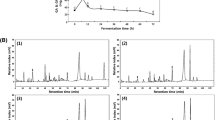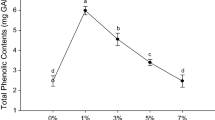Abstract
Changes in β-glycosidase activity, total phenolic and isoflavone contents, and antioxidant activities during the fermentation of brown soybeans (Galmi) fermented food cheonggukjang by the potential probiotic Bacillus subtilis CSY191 were investigated. The total phenolic and isoflavone-glycoside and -aglycone contents as well as ABTS radical scavenging activity and FRAP assays of extracts increased, but malonylglycoside content decreased after a steaming process. It was found that fermentation enhanced the total phenolic and isoflavone-aglycone and -malonylglycoside contents, corresponding to antioxidant activities increased, but isoflavone-glycoside content decreased. The highest levels of daidzein, glycitein, and gensitein were present at concentrations of 156.5 μg/g, 10.2 μg/g, and 2.5 μg/g after 48 h of fermentation. In addition, ABTS radical scavenging activity and FRAP assay increased significantly during fermentation. We suggest that the high antioxidant activity of cheonggukjang of brown soybeans might be related to the markedly higher levels of total phenolic content and isoflavone-aglycones achieved during fermentation.
Similar content being viewed by others
References
Lee JH, Baek IY, Ko JM, Kang NS, Shin SH, Lim SG, Oh KW, Shin SO, Park KY, Park KH, Ha TJ. Antioxidant and tyrosinase inhibitory activities from seed coat of brown soybean. Food Sci. Biotechnol. 17: 1–7 (2008)
Cho KM, Hong SY, Math RK, Lee JH, Kambiranda DM, Kim JM, Md. Islam SA, Yun MG, Cho JJ, Lim WJ, Yun HD. Biotransformation of phenolics (isoflavones, flavanols, and phenolic acids) during the fermentation of cheonggukjang by Bacillus pumilus HY1. Food Chem. 114: 413–419 (2009)
Nam YD, Yi SH, Lim SI. Bacterial diversity of cheonggukjang, a traditional Korean fermented food, analyzed by barcoded pyrosequencing. Food Cont. 28: 135–142 (2012)
Lee JH, Nam SH, Seo WT, Yun HD, Hong SY, Kim MK, Cho KM. The production of surfactin during the fermentation of cheonggukjang by potential probiotic Bacillus subtilis CSY191 and the resultant growth suppression of MCF-7 human breast cancer cells. Food Chem. 131: 1347–1354 (2012)
Nam H, Jung H, Karuppasamy S, Park YS, Cho YS, Lee JY, Seong SI, Suh JG. Anti-diabetic effect of the soybean extract fermented by Bacillus subtilis MORI in db/db mice. Food Sci. Biotechnol. 21: 1669–1676 (2012)
Lee JH, Renita M, Fioritto RJ, St. Martin SK, Schwartz SJ, Vodovotz Y. Isoflavone characterization and antioxidant activity of Ohio soybean. J. Agr. Food Chem. 52: 2647–2651 (2004)
Yang SO, Chang PS, Lee JH. Isoflavone distribution and β-glucosidase activity in cheonggukjang, a traditional Korean whole soybean-fermented food. Food Sci. Biotechnol. 15: 96–101 (2006)
Lee JH, Cho KM. Changes occurring in compositional components of black soybeans maintained at room temperature for different storage periods. Food Chem. 131: 161–169 (2012)
Lee JH, Choung MG. Determination of optimal acid hydrolysis time of soybean isoflavones using drying oven and microwave assisted methods. Food Chem. 129: 577–582 (2011)
Lee SW, Lee JH. Effects of oven-drying, roasting, and explosive puffing process on isoflavone distributions in soybeans. Food Chem. 112: 316–320 (2009)
Kim MH, Kim SY, Ko JM, Jeong DY, Kim YS. Biological activities of cheonggukjang prepared with several soybean cultivars. Food Sci. Biotechnol. 21: 475–483 (2012)
Cho KM, Lee JH, Yun HD, Ahn BY, Kim H, Seo WT. Changes of phytochemical constituents (isoflavones, flavanols, and phenolic acids) during cheonggukjang soybeans fermentation using potential probiotics Bacillus subtilis CS90. J. Food Comp. Anal. 24: 402–410 (2011)
Hu Y, Ge C, Yuan W, Zhu R, Zhang W, Du L, Xue J. Characterization of fermented black soybean natto inoculated with Bacillus natto during fermentation. J. Sci. Food Agr. 90: 1194–1202 (2010)
Choi JS, Kim HY, Seo WT, Lee JH, Cho KM. Roasting enhances antioxidant effect of bitter melon (Momordica charantia L.) increasing in flavan-3-ol and phenolic acid contents. Food Sci. Biotechnol. 21: 19–26 (2012)
Kim MH, Han SY, Ko JM, Kim YS. Degradation characteristics of proteins in cheonggukjang (fermented unsalted soybean paste) prepared with various soybean cultivars. Food Sci. Biotechnol. 21: 9–18 (2012)
Youn KS, Chung HS. Optimization of the roasting temperature and time for preparation of coffee-like maize beverage using the response surface methodology. LWT-Food Sci. Technol. 46: 305–310 (2012)
Chandrasekara N, Shahidi F. Antioxidative potential of cashew phenolics in food and biological model systems as affected by roasting. Food Chem. 129: 1388–1396 (2011)
Robbins RJ. Phenolic acids in foods: An overview of analytical methodology. J. Agr. Food Chem. 51: 2866–2887 (2003)
Shon MY, Lee J, Choi SY, Nam SH, Seo KI, Lee SW, Sung NJ, Park SK. Antioxidant and free radical scavenging activity of methanol extract of chungkukjang. J. Food Comp. Anal. 20: 113–118 (2007)
Juan MY, Chou CC. Enhancement of antioxidant activity, total phenolic and flavonoid content of black soybeans by solid state fermentation with Bacillus subtilis BCRC 14715. Food Microbiol. 27: 586–591 (2010)
Kim HG, Kim GW, Oh H, Yoo SY, Kim YO, Oh MS. Influence of roasting on the antioxidant activity of small black soybean (Glycine max L. Merrill). LWT-Food Sci. Technol. 44: 992–998 (2011)
Pratt DE, Birac PM, Porter WL, Giffee JW. Phenolic antioxidants of soy protein hydrolyzates. J. Food Sci. 47: 24–25 (1981)
Seo A, Morr CV. Improved high-performance liquid chromatographic analysis of phenolic acids. J. Agr. Food Chem. 32: 530–533 (1984)
Jang CH, Lim JK, Kim JH, Park CS, Kwon DY, Kim YS, Shin DH, Kim JS. Change of isoflavone content during manufacturing of cheonggukjang, a traditional Korean fermented soyfood. Food Sci. Biotechnol. 15: 643–646 (2006)
Coward L, Smith M, Kirk M, Barnes S. Chemical modification of isoflavones in soyfoods during cooking and processing. Am. J. Clin. Nutr. 68: 1486–1491 (1998)
Prabhakaran MP, Perera CO, Valiyaveettil S. Effect of different coagulants on the isoflavones levels and physical properties of prepared firm tofu. Food Chem. 99: 492–499 (2006)
Otieno DO, Ashton JF, Shah N. Stability of β-glucosidase activity produced by Bifidobacterium and Lactobacillus spp. in fermented soymilk during processing and storage. J. Food Sci. 70: M236–M241 (2005)
Wang L, Yin L, Li D, Zou L, Saito M, Tatsumi E, Li L. Influecnes of processing and NaCl supplementation on isoflavone contents and composition during douchi manufacturing. Food Chem. 101: 1247–1253 (2007)
Slavin M, Cheng Z, Luther M, Kenworthy W, Yu L. Antioxidant properties and phenolic, isoflavone, tocopherol, and carotenoid composition of Maryland-grown soybean lines with altered fatty acid profiles. Food Chem. 114: 20–27 (2009)
Kao TH, Chen BH. Functional components in soybean cake and their effects on antioxidant activity. J. Agr. Food Chem. 54: 7544–7555 (2006)
Lee CH, Yang L, Xu JZ, Yeung SYV, Huang Y, Chen Z-Y. Relative antioxidant activity of soybean isoflavones and their glycosides. Food Chem. 90: 735–741 (2005)
Kim NY, Song EJ, Kwon DY, Kim HP, Heo MY. Antioxidant and antigenotoxic activities of Korean fermented soybean. Food Chem. Toxicol. 46: 1184–1189 (2008)
Kwak CS, Lee MS, Park SC. Higher antioxidant of chungkookjang, a fermented soybean paste, may be due to increased aglycone and malonylgycoside isoflavone during fermentation. Nutr. Res. 27: 719–727 (2007)
Author information
Authors and Affiliations
Corresponding author
Rights and permissions
About this article
Cite this article
Shin, EC., Lee, J.H., Hwang, C.E. et al. Enhancement of total phenolic and isoflavone-aglycone contents and antioxidant activities during Cheonggukjang fermentation of brown soybeans by the potential probiotic Bacillus subtilis CSY191. Food Sci Biotechnol 23, 531–538 (2014). https://doi.org/10.1007/s10068-014-0073-9
Received:
Revised:
Accepted:
Published:
Issue Date:
DOI: https://doi.org/10.1007/s10068-014-0073-9




